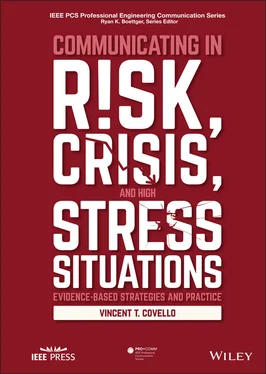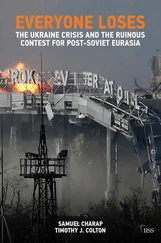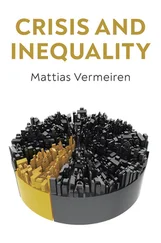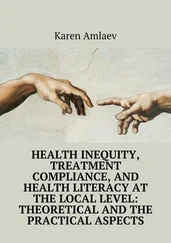1 ...6 7 8 10 11 12 ...40 In April 2020, the UN Secretary‐General launched the United Nations Communications Response initiative to combat the spread of mis‐ and disinformation. At the World Health Assembly in May 2020, the World Health Organization Member States passed a resolution that recognized that effective risk and crisis communication was a critical part of controlling the COVID‐19 pandemic. We continue to learn from the communication failures and successes of the COVID‐19 crisis, and COVID‐19‐related findings, examples, and case studies are contained throughout this book. The experience of the global pandemic profoundly illustrates that successful risk, high concern, and crisis communication plays a critical role in all aspects of human well‐being. The principles and practices described in this book will help its readers achieve a critical positive impact through their communications.
2
Core Concepts
CHAPTER OBJECTIVES
This chapter defines the fields of risk, crisis, and high concern communication and outlines the broad and varied range of situations that require their application.
At the end of this chapter, you will be able to:
describe how risk, high concern, and crisis communication practices can be employed for a wide and varied range of issues;
explain the terms used in risk, high concern, and crisis communication;
explain the defining characteristics of risk, high concern, and crisis situations; and
determine the scope and nature of situations in which you may need to draw on risk, high concern, or crisis communication.
Good words are worth much, and cost little .
— George Herbert.
In this chapter, I define and discuss the core concepts of risk, high concern, and crisis communication. These concepts may appear familiar, but what appears to be a simple concept is often more complex in application. Core concepts provide a framework upon which you can build strategies and action plans. The concepts function as a compass, pointing the user in a particular direction.
I also include a brief history of each core concept as their meanings have morphed or changed. My hope is these brief histories not only are interesting but also suggest alternative ways of thinking about the familiar. For example, one of the original meanings of crisis was a “turning point in a disease; a sudden change for worse or better.” This original meaning suggests a crisis can cause either a bad or a good outcome. The following case diary illustrates the importance of understanding high concern as a core communication concept.
2.1 Case Diary: Recognizing Change as a High Concern Issue
I was in between trips helping clients when I received an urgent call late one Friday night. On the line was the chief executive officer (CEO) of an organization for which I had often done work related to health, safety, and the environment. We knew each other well. Apologizing for the late hour of the call, the CEO said he urgently needed my help. He was about to announce a major change in his organization: he was in the final stages of negotiating the sale of his company to a much larger company.
The CEO said the offer to buy his company came suddenly. It was a generous offer and not a takeover but designed to be extremely beneficial to the mission, operations, personnel, and finances of his company. The company making the offer required a prompt response. He had quickly discussed the offer with his senior managers, the board of directors, and lawyers. All agreed they should accept and begin negotiations about details.
The CEO told me that although negotiations about the sale had to be secret, anxiety‐ridden rumors were already spreading throughout his organization. The rumors were causing staff to imagine that the sale would require many employees to lose their jobs, relocate, change job functions and responsibilities, renegotiate benefits, work longer hours, travel more, and work under new bosses. He said this was not true. The draft agreement with the buyer left jobs and operations virtually the same. The CEO expressed concern about the risk of employees leaving the company based on rumors and misinformation. This situation would become a crisis if the company lost its best people. He expressed high regard for his employees’ talents and believed they held his leadership in high regard. Beyond that, departures of talented staff could jeopardize the sale.
The CEO had prepared a PowerPoint presentation for the following week to announce the purchase to employees. At a minimum, the CEO expected complaints from employees about not receiving enough notice and information. At worst, some employees would leave the company.
I asked the CEO to review his presentation. The first slide in the deck announced the impending sale. It said the sale would be fantastic for the company. Everything he had hoped for the organization could now occur. The slides addressed why the sale was needed to remain competitive, how the sale would benefit stockholders, who would be affected by the sale, what changes could be expected, where changes would likely take place, when the sale would be announced, and how the company would implement changes.
When he finished reviewing his slides, my first thought was – this is not my field. I may need to punt. He really needs an organizational and change management consultant. But then I realized that organizational change communications were a subset of the larger field of risk, high concern, and crisis communication – my specialty.
As with communication about other risks, high concerns, or crisis situations, organizational change initiatives also introduce uncertainty about the future. As discussed in this chapter, the concept of uncertainty is central to the definition of the terms risk, high concern, and crisis . For employees, organizational change threatens and puts at risk many of the things they value, including their autonomy, value, and livelihood. These perceptions of threat can produce a strong emotional reaction just as in the flight‐freeze‐fight response that has kept humans alive for thousands of years. These reactions can severely affect people’s ability to focus, solve problems, communicate, cooperate, and think logically. Communicating successfully in the context of these reactions requires knowledge and implementation of the core concepts, principles, strategies, and tools of risk, high concern, and crisis communication.
I told the CEO the communication strategies we had successfully used together to navigate through the rough waters of previous health, safety, or environmental issues also applied to these current changes. His presentation focused on how the company benefited from the sale, but not the concerns of the employees. It was also too complex to be absorbed by anxious employees. This was not a normal company briefing. I agreed to assemble a communications team with a cross‐section of members of his organization and develop a draft strategic communications plan.
When the team met, we first agreed that providing clear and accurate factual information was a necessary but not sufficient condition for effective communication about a major organizational change.
Second, we needed to work quickly. Leaks about the sale were already occurring and rumors were spreading. We wanted to avoid the appearance we were keeping a secret until the sale papers were signed.
Third, we agreed we needed to do much more communication than a single PowerPoint presentation. We needed to communicate to employees through every available means what the impending sale would mean for them.
Fourth, we agreed the communications strategy would not just be a one‐way transfer of information. We would need to establish effective means for listening to, and exchanging information with, employees. We needed to focus on the concerns of the employees and answer questions, such as what will it mean for me, my job, and my working environment?
Читать дальше












